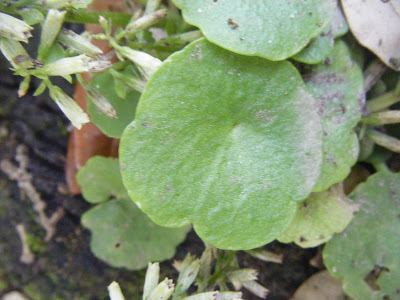With its ghostly, green white, pendulous flowers appearing from May to August, Pennywort (or Navelwort, Umbilicus rupestris) is a common sight on rock crevices and walls throughout Ireland. Prior to the appearance of stalked flowers, the succulent, round leaves of this perennial show depressed centers above the leaf stalk, lending U. rupestris its common names of Pennywort and Navelwort.
It seems to be unaffected by variances in soil pH, thriving in both acidic and calcareous conditions (O'Mahony, 2009 Wildflowers of Cork City and County p. 118) indicating its nutrient demands are quite low.
Living as it does in areas of little soil availability, U. rupestris leaves itself prone to drought. It tackles this stress with a very nifty little metabolic strategy. Under optimal conditions, U. rupestris is a C3 plant, that is it fixes carbon by converting carbon dioxide and ribulose bisphosphate into the 3 carbon 3-phosphoglycerate. However under drought stress, C3 plants close their stomata to reduce water loss which also stops carbon dioxide entering the plant which in turn leads to photorespiration. This limits growth due to a loss of carbon and nitrogen.
U. rupestris overcomes this problem by switching its photosynthesis to an incomplete form of crassulacean acid matabolism (CAM) (Daniel et al., 1984 Biochemical Journal 218 pp. 387-393). CAM photosynthesis fixes carbon dioxide at night to form oxaloacetate, which is in turn converted into malate. In daylight, this malate is decarboxylated and the carbon dioxide is re-fixed via the Calvin cycle. Daniel et al. showed that this switch was accompanied by an increase in the activity of the enzyme phosphoenolpyruvate carboxylate. This enzyme also shows several changes in properties, for example a decrease in sensitivity to acidic pH. This explains its apparent indifference to soil pH.

It seems to be unaffected by variances in soil pH, thriving in both acidic and calcareous conditions (O'Mahony, 2009 Wildflowers of Cork City and County p. 118) indicating its nutrient demands are quite low.
Living as it does in areas of little soil availability, U. rupestris leaves itself prone to drought. It tackles this stress with a very nifty little metabolic strategy. Under optimal conditions, U. rupestris is a C3 plant, that is it fixes carbon by converting carbon dioxide and ribulose bisphosphate into the 3 carbon 3-phosphoglycerate. However under drought stress, C3 plants close their stomata to reduce water loss which also stops carbon dioxide entering the plant which in turn leads to photorespiration. This limits growth due to a loss of carbon and nitrogen.
U. rupestris overcomes this problem by switching its photosynthesis to an incomplete form of crassulacean acid matabolism (CAM) (Daniel et al., 1984 Biochemical Journal 218 pp. 387-393). CAM photosynthesis fixes carbon dioxide at night to form oxaloacetate, which is in turn converted into malate. In daylight, this malate is decarboxylated and the carbon dioxide is re-fixed via the Calvin cycle. Daniel et al. showed that this switch was accompanied by an increase in the activity of the enzyme phosphoenolpyruvate carboxylate. This enzyme also shows several changes in properties, for example a decrease in sensitivity to acidic pH. This explains its apparent indifference to soil pH.




No comments:
Post a Comment